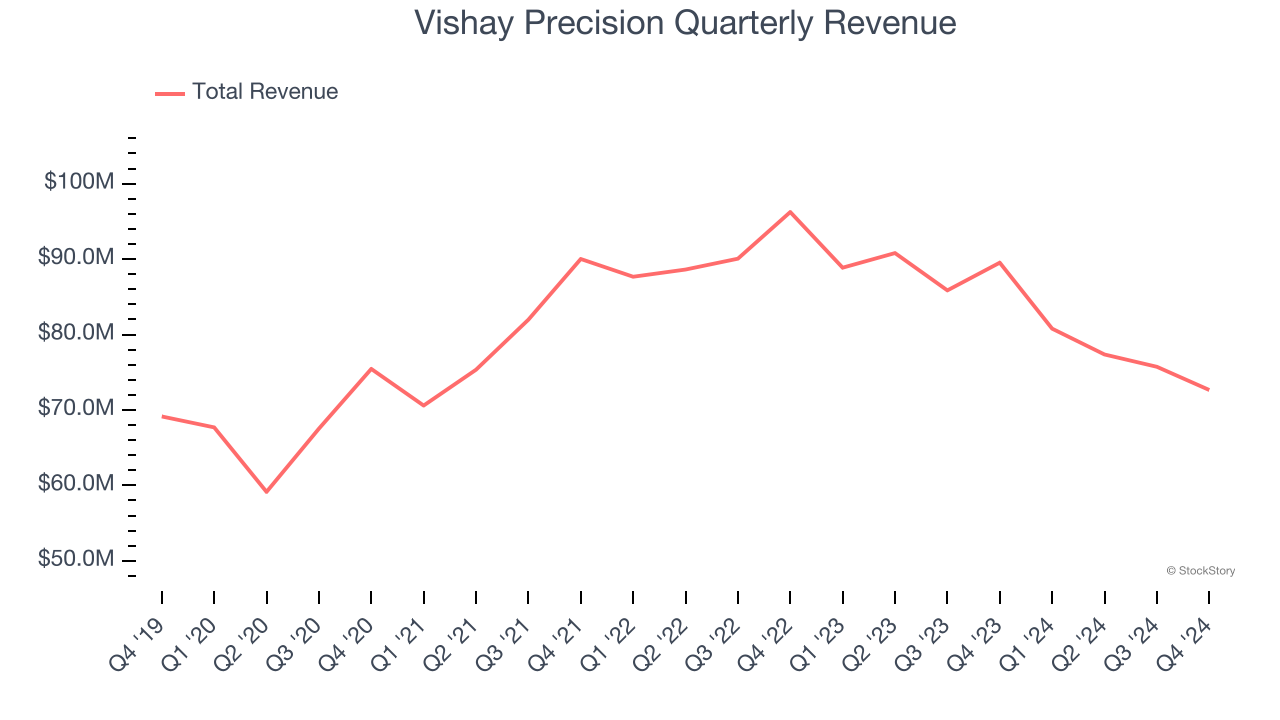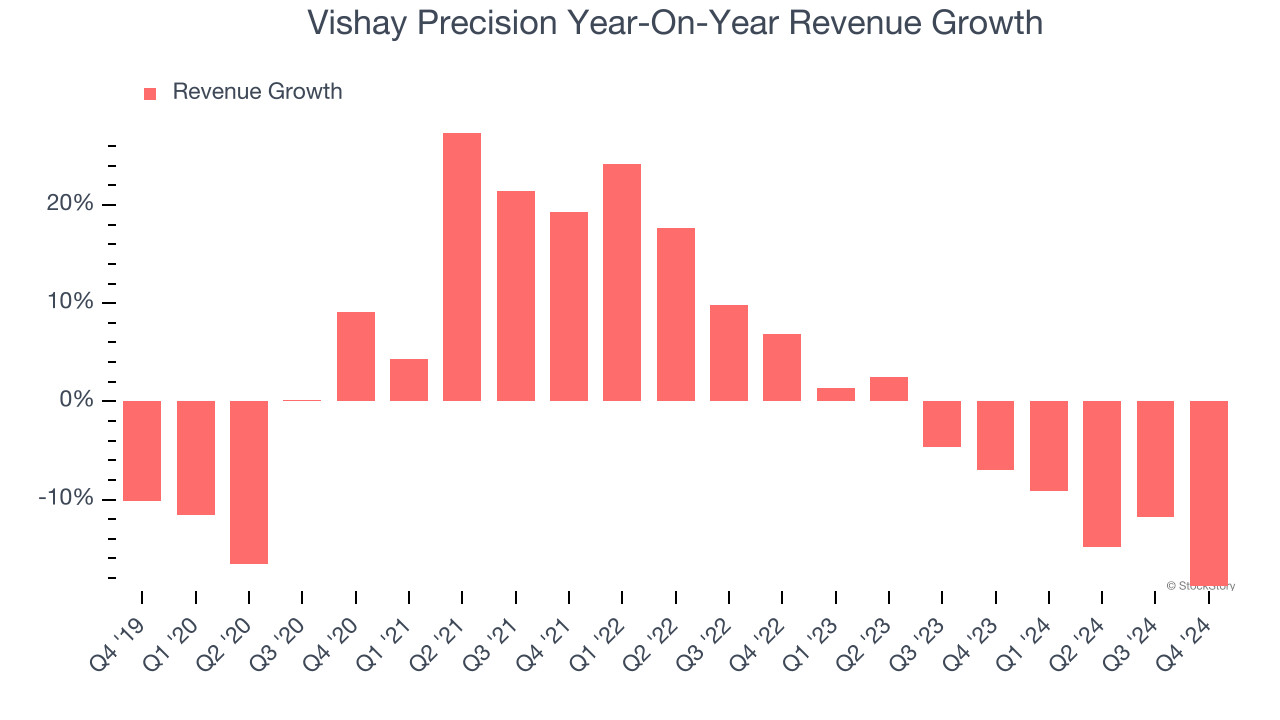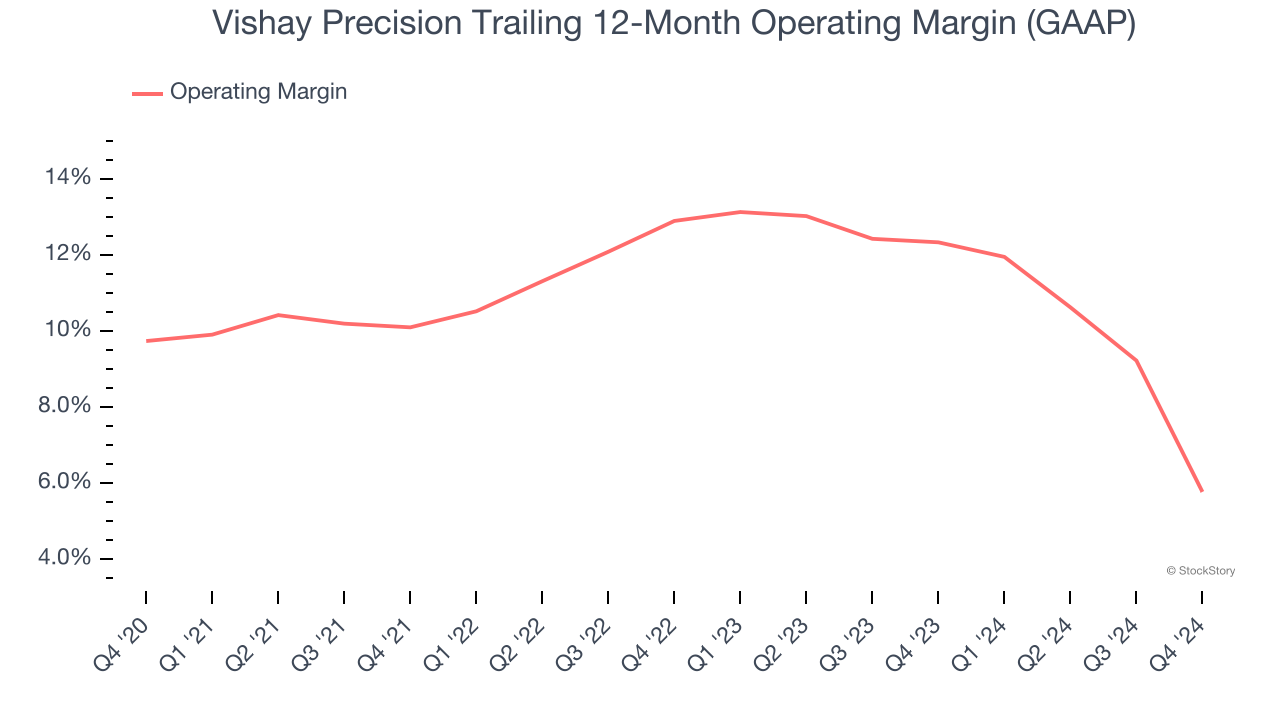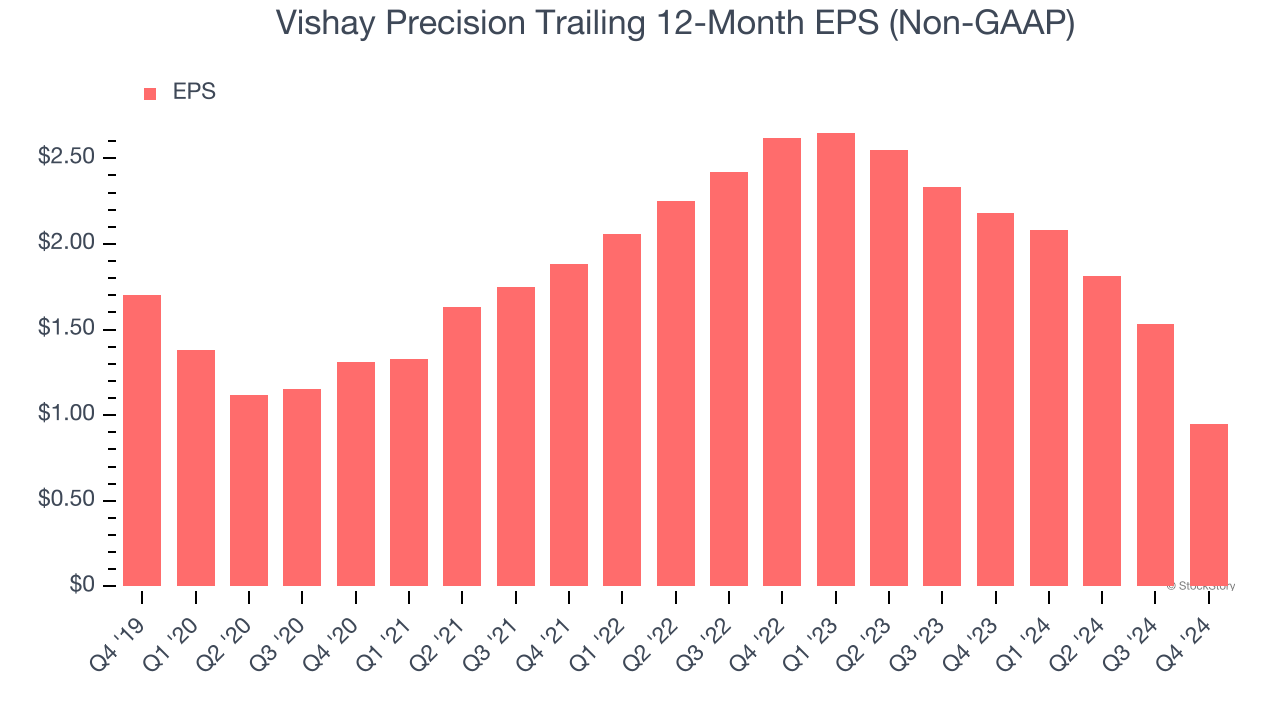
Precision measurement and sensing technologies provider Vishay Precision (NYSE: VPG) fell short of the market’s revenue expectations in Q4 CY2024, with sales falling 18.8% year on year to $72.65 million. Next quarter’s revenue guidance of $73 million underwhelmed, coming in 3.9% below analysts’ estimates. Its non-GAAP profit of $0.03 per share was 77.8% below analysts’ consensus estimates.
Is now the time to buy Vishay Precision? Find out by accessing our full research report, it’s free.
Vishay Precision (VPG) Q4 CY2024 Highlights:
- Revenue: $72.65 million vs analyst estimates of $73.64 million (18.8% year-on-year decline, 1.3% miss)
- Adjusted EPS: $0.03 vs analyst expectations of $0.14 (77.8% miss)
- Adjusted EBITDA: $5.08 million vs analyst estimates of $6.91 million (7% margin, 26.6% miss)
- Revenue Guidance for Q1 CY2025 is $73 million at the midpoint, below analyst estimates of $75.94 million
- Operating Margin: 0.3%, down from 13.8% in the same quarter last year
- Free Cash Flow Margin: 6.3%, down from 15.1% in the same quarter last year
- Market Capitalization: $318 million
Ziv Shoshani, Chief Executive Officer of VPG, commented, "2024 proved to be a challenging year, as we faced macro and cyclical headwinds. Nonetheless, orders in the fourth fiscal quarter of $72.4 million grew 5.5% sequentially resulting in a book-to-bill ratio of 1.00. This marked the first fiscal quarter of sequential bookings growth in six quarters, driven by our Sensors and Weighing Solutions segments which achieved book-to-bill ratios above 1.00 and their highest bookings level in 2024. We continue to focus on our business development pipeline, and furthering our progress with key projects in industrial and medical robotics, data center and telecommunications applications, among others.
Company Overview
Emerging from Vishay Intertechnology in 2010, Vishay Precision (NYSE: VPG) operates as a global provider of precision measurement and sensing technologies.
Electronic Components
Like many equipment and component manufacturers, electronic components companies are buoyed by secular trends such as connectivity and industrial automation. More specific pockets of strong demand include data centers and telecommunications, which can benefit companies whose optical and transceiver offerings fit those markets. But like the broader industrials sector, these companies are also at the whim of economic cycles. Consumer spending, for example, can greatly impact these companies’ volumes.
Sales Growth
Examining a company’s long-term performance can provide clues about its quality. Any business can put up a good quarter or two, but the best consistently grow over the long haul. Regrettably, Vishay Precision’s sales grew at a sluggish 1.5% compounded annual growth rate over the last five years. This was below our standards and is a poor baseline for our analysis.

Long-term growth is the most important, but within industrials, a half-decade historical view may miss new industry trends or demand cycles. Vishay Precision’s history shows it grew in the past but relinquished its gains over the last two years, as its revenue fell by 8.1% annually. 
This quarter, Vishay Precision missed Wall Street’s estimates and reported a rather uninspiring 18.8% year-on-year revenue decline, generating $72.65 million of revenue. Company management is currently guiding for a 9.6% year-on-year decline in sales next quarter.
Looking further ahead, sell-side analysts expect revenue to grow 2.5% over the next 12 months. While this projection implies its newer products and services will catalyze better top-line performance, it is still below average for the sector.
Software is eating the world and there is virtually no industry left that has been untouched by it. That drives increasing demand for tools helping software developers do their jobs, whether it be monitoring critical cloud infrastructure, integrating audio and video functionality, or ensuring smooth content streaming. Click here to access a free report on our 3 favorite stocks to play this generational megatrend.
Operating Margin
Vishay Precision has managed its cost base well over the last five years. It demonstrated solid profitability for an industrials business, producing an average operating margin of 10.3%. This result isn’t surprising as its high gross margin gives it a favorable starting point.
Looking at the trend in its profitability, Vishay Precision’s operating margin decreased by 4 percentage points over the last five years. Even though its historical margin is high, shareholders will want to see Vishay Precision become more profitable in the future.

In Q4, Vishay Precision’s breakeven margin was down 13.5 percentage points year on year. Since Vishay Precision’s operating margin decreased more than its gross margin, we can assume it was recently less efficient because expenses such as marketing, R&D, and administrative overhead increased.
Earnings Per Share
Revenue trends explain a company’s historical growth, but the long-term change in earnings per share (EPS) points to the profitability of that growth – for example, a company could inflate its sales through excessive spending on advertising and promotions.
Sadly for Vishay Precision, its EPS declined by 11% annually over the last five years while its revenue grew by 1.5%. This tells us the company became less profitable on a per-share basis as it expanded due to non-fundamental factors such as interest expenses and taxes.

We can take a deeper look into Vishay Precision’s earnings to better understand the drivers of its performance. As we mentioned earlier, Vishay Precision’s operating margin declined by 4 percentage points over the last five years. This was the most relevant factor (aside from the revenue impact) behind its lower earnings; taxes and interest expenses can also affect EPS but don’t tell us as much about a company’s fundamentals.
Like with revenue, we analyze EPS over a shorter period to see if we are missing a change in the business.
For Vishay Precision, its two-year annual EPS declines of 39.8% show it’s continued to underperform. These results were bad no matter how you slice the data.
In Q4, Vishay Precision reported EPS at $0.03, down from $0.61 in the same quarter last year. This print missed analysts’ estimates. Over the next 12 months, Wall Street expects Vishay Precision’s full-year EPS of $0.95 to grow 13.2%.
Key Takeaways from Vishay Precision’s Q4 Results
We struggled to find many positives in these results. Its EBITDA missed significantly and its EPS fell short of Wall Street’s estimates. Overall, this quarter could have been better. The stock traded down 4.1% to $23 immediately after reporting.
Vishay Precision underperformed this quarter, but does that create an opportunity to invest right now? We think that the latest quarter is only one piece of the longer-term business quality puzzle. Quality, when combined with valuation, can help determine if the stock is a buy. We cover that in our actionable full research report which you can read here, it’s free.






